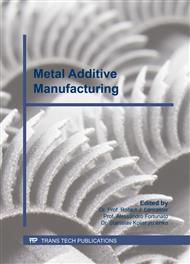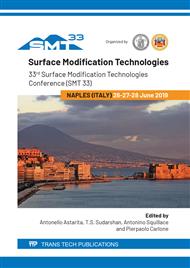p.159
p.165
p.171
p.178
p.185
p.191
p.197
p.203
p.209
Optimization of Microstructural Evolution during Laser Cladding of Ni Based Powder on GCI Glass Molds
Abstract:
In glass industry, laser cladding is an innovative surfacing technique allowing to deposit a layer of nickel to protect glass mold against corrosion, abrasion and thermal fatigue. This method (powder fusion by projection), well known in additive manufacturing represents a real technological leap for the glass industry. But during laser cladding of Ni-based powder on gray cast iron, cracks can be observed for some process conditions. These cracks are often due to the Heat Affected Zone that creates structural stresses linked to the development of a martensitic structure in the ferritic matrix of the lamellar graphite cast iron. The aim of this work is to observe the impact of laser cladding (without substrate pre-heating usually employed to limit cracking) on the coating behavior but also on the flake-graphite cast iron substrates. The microstructure and the mechanical properties were studied (SEM and microanalysis, microhardness) around the interface cladding/substrate. Also, the impact of the processing parameters (power P (1500-2300 W), scanning speed v (2.5-10 mm/s) and powder feeding rate PFR (24.5-32.5 g/min) was studied by using the ANOVA (ANalysis Of VAriance) technique. It has been observed that laser cladding on graphite cast iron is possible without cracks by limiting the linear energy induced by the process. Also, an optimization of the processing parameters (P, v, PFR) in order to obtain the industrial expected geometry of the coating has been proposed.
Info:
Periodical:
Pages:
185-190
Citation:
Online since:
July 2019
Keywords:
Price:
Сopyright:
© 2019 Trans Tech Publications Ltd. All Rights Reserved
Share:
Citation:



